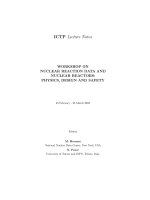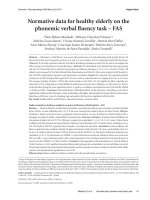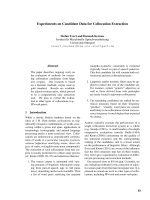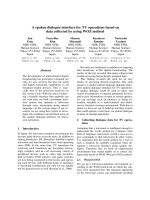Decision Trees Workshop on Data for NLP
Bạn đang xem bản rút gọn của tài liệu. Xem và tải ngay bản đầy đủ của tài liệu tại đây (6.83 MB, 254 trang )
Writing Code for
NLP
Who we are
Matt Gardner (@nlpmattg)
Matt is a research scientist on AllenNLP. He was the original
architect of AllenNLP, and he co-hosts the NLP Highlights podcast.
Mark Neumann (@markneumannnn)
Mark is a research engineer on AllenNLP. He helped build AllenNLP
and its precursor DeepQA with Matt, and has implemented many of
the models in the demos.
Joel Grus (@joelgrus)
Joel is a research engineer on AllenNLP, although you may know
him better from "I Don't Like Notebooks" or from "Fizz Buzz in
Tensorflow" or from his book Data Science from Scratch.
Outline
● How to write code when prototyping
● Developing good processes
BREAK
● How to write reusable code for NLP
● Case Study: A Part-of-Speech Tagger
● Sharing Your Research
What we expect you
know already
What we expect you know already
modern (neural) NLP
What we expect you know already
Python
What we expect you know already
the difference between good science and bad science
What you'll learn
today
What you'll learn today
how to write code in a way that facilitates good science and
reproducible experiments
What you'll learn today
how to write code in a way that makes your life easier
The Elephant in the Room: AllenNLP
● This is not a tutorial about AllenNLP
● But (obviously, seeing as we wrote it)
AllenNLP represents our experiences
and opinions about how best to write
research code
● Accordingly, we'll use it in most of our
examples
● And we hope you'll come out of this
tutorial wanting to give it a try
● But our goal is that you find the tutorial
useful even if you never use AllenNLP
AllenNLP
Two modes of writing
research code
1: prototyping
2: writing
components
Prototyping New
Models
Main goals during prototyping
-
Write code quickly
-
Run experiments, keep track of what you tried
-
Analyze model behavior - did it do what you wanted?
Main goals during prototyping
-
Write code quickly
-
Run experiments, keep track of what you tried
-
Analyze model behavior - did it do what you wanted?
Writing code quickly - Use a framework!
Writing code quickly - Use a framework!
-
Training loop?
Writing code quickly - Use a framework!
-
Training loop?
model = LSTMTagger(EMBEDDING_DIM, HIDDEN_DIM,
len(word_to_ix), len(tag_to_ix))
loss_function = nn.NLLLoss()
optimizer = optim.SGD(model.parameters(), lr=0.1)
validation_losses = []
patience = 10
for epoch in range(1000):
training_loss = 0.0
validation_loss = 0.0
for dataset, training in [(training_data, True),
(validation_data, False)]:
correct = total = 0
torch.set_grad_enabled(training)
t = tqdm.tqdm(dataset)
for i, (sentence, tags) in enumerate(t):
model.zero_grad()
model.hidden = model.init_hidden()
sentence_in = prepare_sequence(sentence, word_to_ix)
targets = prepare_sequence(tags, tag_to_ix)
tag_scores = model(sentence_in)
loss = loss_function(tag_scores, targets)
predictions = tag_scores.max(-1)[1]
correct += (predictions == targets).sum().item()
total += len(targets)
accuracy = correct / total
if training:
loss.backward()
training_loss += loss.item()
t.set_postfix(training_loss=training_loss/(i + 1),
accuracy=accuracy)
optimizer.step()
else:
validation_loss += loss.item()
t.set_postfix(validation_loss=validation_loss/(i +
1),
accuracy=accuracy)
validation_losses.append(validation_loss)
if (patience and
len(validation_losses) >= patience and
validation_losses[-patience] ==
min(validation_losses[-patience:])):
print("patience reached, stopping early")
break
Writing code quickly - Use a framework!
-
Tensorboard logging?
Model checkpointing?
Complex data processing, with smart batching?
Computing span representations?
Bi-directional attention matrices?
-
Easily thousands of lines of code!
Writing code quickly - Use a framework!
-
Don’t start from scratch! Use someone else’s components.
Writing code quickly - Use a framework!
-
But...
Writing code quickly - Use a framework!
-
But...
-
Make sure you can bypass the abstractions when you need to
Writing code quickly - Get a good starting place
Writing code quickly - Get a good starting place
-
First step: get a baseline running
-
This is good research practice, too









